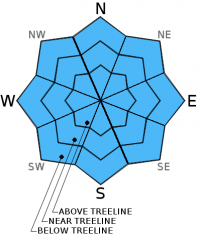| Saturday | Saturday Night | Sunday | |
|---|---|---|---|
| Weather: | Partly cloudy becoming mostly cloudy | Mostly cloudy | Mostly cloudy |
| Temperatures: | 23 to 30 deg. F. | 19 to 25 deg. F. | 30 to 37 deg. F. |
| Mid Slope Winds: | South | South | Southeast |
| Wind Speed: | 15 to 25 mph with gusts to 30 mph increasing to 40 mph in the afternoon | 15 to 25 mph with gusts to 35 mph | 20 to 30 mph with gusts to 40 mph |
| Expected snowfall: | 0 | 0 | 0 |
| Saturday | Saturday Night | Sunday | |
|---|---|---|---|
| Weather: | Partly cloudy becoming mostly cloudy | Mostly cloudy | Mostly cloudy |
| Temperatures: | 22 to 29 deg. F. | 16 to 23 deg. F. | 28 to 35 deg. F. |
| Ridge Top Winds: | Southwest | South | South |
| Wind Speed: | 25 to 30 mph with gusts to 50 mph increasing to 35 to 40 mph with gusts to 60 mph in the afternoon | 30 to 40 mph with gusts to 60 mph | 30 to 40 mph with gusts to 60 mph |
| Expected snowfall: | 0 | 0 | 0 |























